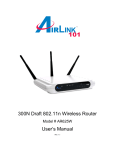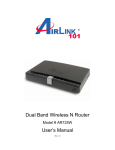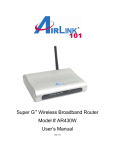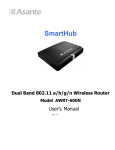Download Digitus Wireless Internet Broadband User`s manual
Transcript
MIMO XR™ Wireless Broadband Router Model # AR525W User’s Manual Ver. 1B Table of Contents 1. Introduction................................................................................................................................. 3 2. Connecting the Router ................................................................................................................ 4 3. Verifying Connection to the Router............................................................................................ 5 4. Configuring the Router ............................................................................................................... 8 Cable Modem.............................................................................................................................. 9 DSL ........................................................................................................................................... 10 5. Connecting to the Router Wirelessly ........................................................................................ 11 6. Web Configuration Utility ........................................................................................................ 12 6.1 Setup ................................................................................................................................... 12 6.1.1 Basic Setup....................................................................................................................... 12 6.1.2 DDNS............................................................................................................................... 14 6.1.3 MAC Address Clone........................................................................................................ 15 6.1.4 Advanced Routing ........................................................................................................... 16 6.2. Wireless.............................................................................................................................. 17 6.2.1 Basic Wireless Settings.................................................................................................... 17 6.2.2 Wireless Security ............................................................................................................. 18 WEP ...................................................................................................................................... 18 WPA...................................................................................................................................... 19 WPA with RADIUS.............................................................................................................. 20 6.2.3 Wireless MAC Filter........................................................................................................ 21 6.2.4 Advanced Wireless Settings ............................................................................................ 22 6.3 Security ............................................................................................................................... 23 6.3.1 Firewall ............................................................................................................................ 23 6.3.2 VPN Passthrough ......................................................................................................... 24 6.4 Access Restrictions ............................................................................................................. 25 6.4.1 Internet Access Policy...................................................................................................... 25 6.5 Applications & Gaming ...................................................................................................... 28 6.5.1 Single Port Forwarding .................................................................................................... 28 6.5.2 Port Range Forwarding .................................................................................................... 29 6.5.3 Port Range Triggering...................................................................................................... 30 6.5.4 DMZ................................................................................................................................. 31 6.5.5 QoS .................................................................................................................................. 32 6.6 Administration .................................................................................................................... 33 6.6.1 Management..................................................................................................................... 33 6.6.2 Log ................................................................................................................................... 34 6.6.3 Diagnostics....................................................................................................................... 35 6.6.4 Factory Defaults............................................................................................................... 36 6.6.5 Firmware Upgrade ........................................................................................................... 37 6.7 Status................................................................................................................................... 38 6.7.1 Router............................................................................................................................... 38 6.7.2 Local Network ................................................................................................................. 39 6.7.3 Wireless Network............................................................................................................. 40 7. Troubleshooting ........................................................................................................................ 41 Technical Support ......................................................................................................................... 42 2 1. Introduction Congratulations on your purchase of this MIMO XR™ Wireless Broadband Router. The MIMO XR™ Wireless Broadband Router allows Internet sharing and creates a dynamic wireless network for you to access your network with greater mobility. When used with other Airlink101™ MIMO XR™ wireless products, the wireless signal range extends farther than standard 802.11g products. Best of all the MIMO XR™ Wireless Broadband Router is backwards-compatible with existing 802.11g and 802.11b network devices. This product is specifically designed for Small Office and Home Office needs. It provides a complete SOHO solution for Internet surfing and is easy to configure and operate even for non-technical users. Instructions for installing and configuring this product can be found in this manual. Before you install and use this product, please read this manual carefully for proper operation of this product. Package Contents Before you begin the installation, please check the items of your package: • • • • • • One MIMO XR™ Wireless Broadband Router One RJ-45 cable Three Detachable Antennas One Power Adapter One Quick Installation Guide One Manual CD If any item contained is damaged or missing, please contact your local dealer immediately. Also, keep the box and packaging materials in case you need to ship the unit in the future. 3 2. Connecting the Router Note: Prior to connecting the router, be sure to power off your computer, DSL/Cable modem, and the router. To achieve maximum wireless coverage, tilt the router’s antennas outward at 45° angle. Step 1 Connect one end of a network cable to the WAN port of the router and connect the other end of the cable to the DSL/Cable modem. Step 2 With another network cable, connect one end of the cable to your computer’s network card and connect the other end to one of the LAN ports of the router. Step 3 Power on the DSL/Cable modem and wait for the lights on the modem to settle down. Step 4 Power on the router by connecting one end of the supplied power adapter to the power jack of the router and connecting the other end to an electrical outlet. Step 5 Power on your computer. Step 6 Make sure the WAN, WLAN, and the LAN ports that the computer is connected to are lit. If not, try the above steps again. 4 3. Verifying Connection to the Router Step 1 Go to Start, Run, type command (for Windows 95/98/ME) or cmd (for Windows 2000/XP) and click OK. You will see the command prompt as below. Step 2 Type ping 192.168.1.1 and press Enter. You should get four reply responses back. Step 3 If you get Request timed out, or Destination host unreachable, double-check the network cable connection between the computer and the router and try Step 2 again. If you still encounter problem, go to the next step; otherwise proceed to Section 3, Configure the Router. Step 4 For Windows 2000/XP, type ipconfig/release and press Enter. 5 Step 5 Type ipconfig/renew and press Enter. You should get an IP address of 192.168.1.x (where x is a number between 2 - 254). Proceed to Section 3, Configure the Router. If you don’t get an IP address, reset the router by holding in the reset button at the back of the router for 10 seconds while it is ON and try ipconfig/renew again. Step 6 For Windows 95/98/ME go to Start, Run, type winipcfg and click OK. Step 7 Select your network card from the drop-down menu and click Release. 6 Step 8 After your IP address is released, click Renew. You should get an IP address of 192.168.1.x (where x is a number between 2 - 254). If you don’t get an IP address, reset the router by holding in the reset button at the back of the router for 10 seconds while it is ON and try Renew again. 7 4. Configuring the Router Step 1 Open the web browser and type 192.168.1.1 in the URL Address field and press Enter. Step 2 Enter admin for both the username and password fields and click OK. 8 Cable Modem For most cable modem users, you should be able to connect to the Internet without any configuration. If your ISP has provided you with a host name, enter it in the optional Host Name field. Click Apply to save the setting. If your ISP requires a registered MAC Address, click on the MAC Address Clone tab, select Enabled, and click on the Clone My PC’s MAC button. Click Apply to save the setting. If you have trouble connecting to the Internet, please refer to the Troubleshooting section at the end of this guide. 9 DSL For DSL users, follow the steps below to configure the router. Step 1 Select PPPoE from the drop-down menu. Step 2 Enter your username and password provided by your ISP. Note: Depending on the ISP, you may need to include the domain name with your username. Example: [email protected] Step 3 Click Apply to save the setting. If you have trouble connecting to the Internet, please refer to the Troubleshooting section at the end of this manual. 10 5. Connecting to the Router Wirelessly Below are the default wireless settings of the router. You must configure your wireless network card to the same settings in order to establish a wireless connection to the router. Please refer to your wireless network card’s manual on how to configure these settings. SSID (Network Name): default Operating Mode: Infrastructure Authentication: Auto Channel #: 6 Encryption: Disabled If you want to change the router’s wireless settings, log in to the router and select the Wireless tab. Be sure to click Apply to save the setting. 11 6. Web Configuration Utility This router has a built-in web configuration utility that you can use to configure the router’s settings. Simply log in to the router using your computer’s web browser. 6.1 Setup 6.1.1 Basic Setup This is the default screen when you log in to the router’s web configuration utility. You can setup your Internet connection here as well as configuring the DHCP settings and selecting your Time Zone. Remember to click Apply to save your changes. 12 Assigning Static IP Address If you want to assign a static IP Address to one of the computers in your network, click on the Static DHCP button. Step 1 Enter the Static IP Address in the Assign this IP field. Step 2 Enter the MAC address of the corresponding computer in the To this MAC field. Step 3 Check the Enabled box. Step 4 Click Save Settings. 13 6.1.2 DDNS Dynamic DNS (DDNS) allows any user who wishes to access your server to reach it by a registered DNS name instead of an IP address. Before you enable DDNS, you need to register an account with one of the DDNS providers listed in the drop-down menu. To Enable DDNS, select the DDNS provider you have registered with and enter the required fields. Click Apply to save the setting. 14 6.1.3 MAC Address Clone Some ISPs require a registered MAC address to access the Internet. You can use the following steps to clone your PC’s registered MAC address to access the Internet. Step 1 Select Enabled from the drop-down menu. Step 2 Click the Clone My PC’s MAC button. Step 3 Click Apply to save the setting. 15 6.1.4 Advanced Routing You can configure your own static routing table using the Advanced Routing function. To see the current routing table, click on Show Routing Table button. Be sure to click Apply to save each entry. 16 6.2. Wireless 6.2.1 Basic Wireless Settings You can configure the router’s basic wireless settings on this screen. Wireless: Select to Enable or Disable the wireless feature of the router. Network Mode: Choose from Mixed (B & G), Wireless-B only, and Wireless-G only. Network Name (SSID): You can change the router’s SSID in this field. Once you have changed the SSID, your network clients need to re-connect themselves using the new SSID. Channel: Select the desired channel. All the network clients need to use the same channel. SSID Broadcast: Choose to enable or disable the broadcast of your SSID. 17 6.2.2 Wireless Security You can configure wireless security such as WEP or WPA encryption on this screen. Note: It is recommended that you use WPA encryption over WEP if your wireless clients support WPA. All of the wireless clients must use the same security settings in order to connect to the router. WEP To enable WEP, select WEP from the Security Mode. Encryption: Choose from 64 bits or 128 bits Passphrase: You can enter a passphrase and click on the Generate button and the router will automatically generate four WEP keys for you. WEP Key 1 – 4: Manually assign a passphrase for each key. If you selected 64 bits encryption, enter 10 HEX characters (0-F) for each key. If you selected 128 bits encryption, enter 26 HEX characters (0-F) for each key. TX Key: Select a key to be the active key. Click Apply to save the setting. 18 WPA To enable WPA, select WPA-PSK or WPA2-PSK from the Security Mode. Encryption: Select either TKIP or AES as the encryption method. Passphrase: Enter a passphrase between 8 to 63 characters long. Key Renewal: Enter the desired key renewal time in seconds. Click Apply to save the setting. 19 WPA with RADIUS If you are using a RADIUS server in your network for authentication, you may choose WPA or WPA2 from the Security Mode. Encryption Methods: Select either TKIP or AES as the encryption method. (WPA2 uses AES only). RADIUS Server: Enter the IP Address of your RADIUS server. RADIUS Port: Enter the port number of your RADIUS server. Shared Secret: Enter the shared key. Key Renewal: Enter the desired key renewal time in seconds. Click Apply to save the setting. 20 6.2.3 Wireless MAC Filter You can restrict certain wireless clients from accessing the router by specifying their MAC address and enabling access restriction. Select Enabled and choose whether the specified wireless clients will be prevented or permitted to access the wireless network. Enter their MAC address in the fields below and click Apply to save the setting. 21 6.2.4 Advanced Wireless Settings You can configure various advanced wireless settings on this screen. Click Apply to save the setting. 22 6.3 Security 6.3.1 Firewall SPI Firewall Protection: Select to enable or disable Stateful Packet Inspection. Internet Filter: Place a check to enable various Internet filter including Anonymous Internet Requests, Multicast packets, NAT Redirection, and IDNT port. Web Filters: You can select to filter Proxy, Java, ActiveX, and/or Cookies. Click Apply to save the setting. 23 6.3.2 VPN Passthrough You can select to enable or disable the passthrough of IPSec, PPTP, and/or L2TP. Click Apply to save the setting. 24 6.4 Access Restrictions 6.4.1 Internet Access Policy You can setup policies that deny or allow specific clients to access the Internet. Enter Policy Name: Enter a name for the policy. Status: Choose to enable or disable the selected policy. 25 PCs: Click on the Edit List button to specify the network clients. Policy only applies to the PCs that are in the list. You can specify each client by its MAC Address or IP Address. You can also specify a group of clients by entering their IP Address Range. Once you have specified all the clients, click Save Settings. Access Restrictions: Select to Deny or Allow the specified clients to access the Internet by Day and Time. 26 Blocked Application Port Select which application port to block, if any, when the specified PCs have Internet access. For your convenience, 10 preset applications and their ports are listed. If you have a custom application, manually enter its name, port range, protocol and click Add. Website Blocking You can block the specified clients from accessing certain websites by URL or Keyword. Enter the URL or the Keyword you wish to block. Click Apply to save the setting. To view all the policies, click the Summary button. 27 6.5 Applications & Gaming 6.5.1 Single Port Forwarding If you want to host ftp server or online gaming, you must open up ports on the router. This page allows you to setup single port forwarding for the specified applications. Before using forwarding, you should assign static IP addresses to the designated PCs. Click Apply to save the setting. 28 6.5.2 Port Range Forwarding If you want to host ftp server or online gaming, you must open up ports on the router. This page allows you to setup port range forwarding for the specified applications. Before using forwarding, you should assign static IP addresses to the designated PCs. Click Apply to save the setting. 29 6.5.3 Port Range Triggering Port triggering allows the router to keep track of outgoing data for specific port numbers. The router remembers which computer sends out what data, so when the requested data returns through the router, the data is sent back to the proper computer by way of IP address and port mapping rules. Click Apply to save the setting. 30 6.5.4 DMZ DMZ (De-Militarized Zone) Host is a host without the protection of the router’s firewall. It allows a computer to be exposed to unrestricted two-way communication with the Internet. You should only use this feature when the Port Forwarding function fails to make an application work. Warning: Setting your computer as a DMZ host exposes it to various security vulnerabilities. This feature should be used only when needed. DMZ: Select to enable or disable DMZ. Source IP Address: Select any source IP address or specify a source IP address. Destination: Specify the Destination by its IP Address or MAC Address. Note: Any DMZ host should have a new static IP address assigned to it because its IP address may change when using the DHCP function. Click Apply to save the setting. 31 6.5.5 QoS QoS (Quality of Service) manages information as it is transmitted and received. It ensures better service to those applications with a higher priority. Click Apply to save the setting. 32 6.6 Administration 6.6.1 Management The Management screen allows you to change the router’s log in password as well as other administrative settings. Router Password: Set the router’s log in password. Web Access: Select to enable or disable HTTPs and Wireless access for the Web Configuration Utility. Remote Router Access: Select to enable or disable remote management/upgrade of the router. You can allow remote management from any IP Address or a specified IP Address as well as the port number. Backup and Restore: You can choose to backup the router’s settings so that you don’t have to manually configure the settings again if you reset the router to factory default. 33 UPnP: Universal Plug and Play (UPnP) allows Windows Me and XP to automatically configure the router for various Internet applications, such as gaming and videoconferencing. 6.6.2 Log You can choose to enable or disable logging of your network activity on this screen. Click Apply and to save the setting. 34 6.6.3 Diagnostics The Diagnostics screen allows you to perform Ping and Traceroute tests. Ping Test: Enter the IP or URL Address you wish to ping and click Start to Ping. Traceroute: Enter the IP or URL Address you wish to trace and click Start to Traceroute. 35 6.6.4 Factory Defaults The Factory Defaults screen allows you to set all the router’s settings to the factory default. Click on the Restore Factory Defaults button to restore all the settings to default. 36 6.6.5 Firmware Upgrade The Firmware Upgrade screen allows you to upgrade the router’s firmware. You must download and unzip the new firmware first from www.airlink101.com Click on Browse to browse to the new firmware, and click Start to Upgrade. 37 6.7 Status 6.7.1 Router The Router screen displays various status of the router including the firmware version. Click on the Refresh button to reload the screen. 38 6.7.2 Local Network The Local Network screen displays various status about your Local Area Network. Click on the DHCP Client Table to display a list of all the DHCP clients in your network. 39 6.7.3 Wireless Network The Wireless Network screen displays various status about your wireless network. 40 7. Troubleshooting If you have trouble connecting to the Internet, try the following steps. Step 1 Power off the Cable/DSL modem, router, and computer and wait for 5 minutes. Step 2 Turn on the Cable/DSL modem and wait for the lights on the modem to settle down. Step 3 Turn on the router and wait for the lights on the router to settle down. Step 4 Turn on the computer. Step 5 Reconfigure the router as described in Section 3. Step 6 Log in to the router and select the Status tab. Step 7 Verify that the IP Address, Default Gateway, and at least one of the DNS fields have valid numbers assigned to them (instead of all 0’s). If you see all 0’s, click on the IP Renew button (for Cable Modem users) or the Connect button (for DSL users). If each field has a valid number assigned, the router is connected to the Internet. 41 Technical Support E-mail: [email protected] Toll Free: 1-888-746-3238 Web Site: www.airlink101.com *Theoretical maximum wireless signal rate based on IEEE standard 802.11g specifications. Actual data throughput will vary. Network conditions and environmental factors, including volume of network traffic, building materials and construction, mix of wireless products used, radio frequency interference (e.g., cordless telephones and microwaves) as well as network overhead lower actual data throughput rate. Copyright © 2005 AirLink101. All rights reserved. AirLink101, the stylized AirLink101 logo, specific product designations, and all other words and logos that are identified as trademarks and/or service marks are, unless noted otherwise, the trademarks and service marks of AirLink101. All other product or service names are the property of their respective holders. AirLink101 products are protected under numerous U.S. and foreign patents and pending applications, mask work rights, and copyrights. 42



















































